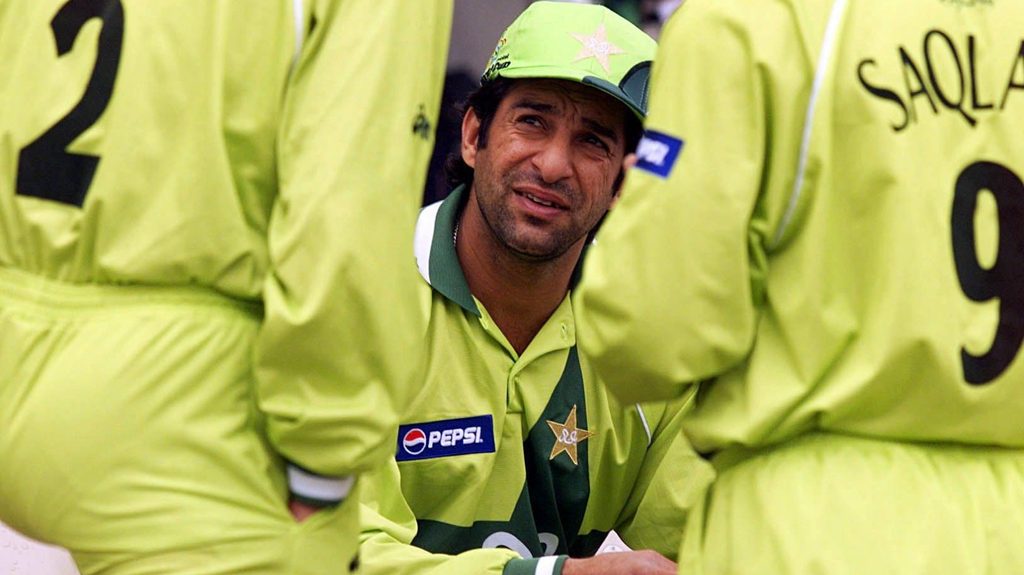
When Pakistan bowler Wasim Akram made his international debut in 1985 at the age of 17, cricket was a bowler’s game and youngsters had enough idols who inspired them to pursue fast bowling.
The speeding circuit was ruled by the menacing likes of Malcolm Marshall, Richard Hadlee, Dennis Lillee, Joel Garner and Pakistan's very own Imran Khan, and the poster boys were all using brute strength to win bouncer wars and intimidate batsmen.
However, an intellectual Wasim Akram - who idolized Zaheer Abbas, Asif Iqbal and Mushtaq Mohammad - always saw fast bowling in terms of dimensions and new angle lines rather than repetitive hitting of the deck at shorter lengths.
“Fast bowling is not all about fitness and power; it is not about big, dumb men with biceps and triceps,” Wasim Akram would say in an interview with Cricket Monthly.
“You need to be able to analyze the weaknesses of the batsman, read the conditions, use the conditions,” added the Pakistan bowler.
The battle of man versus nature has been older than time, but little did a young Wasim Akram know that he would end up bending the very laws of nature to find his place in cricketing history.
While many would label Wasim Akram as an inborn talent, all the Lahore lad had from the beginning was a distinct imagination. And it was more of a curse than a gift because Akram would injure every pivotal part of his body to attain the perfection that his fascination projected.
The byproduct was the most complete fast bowler cricket ever produced. At his peak, Akram could hit the same spot four times with the ball acting in four different ways. He wasn’t the fastest bowler in the world but his deliveries would come in, go out – both over and round the wicket – see an early swing and vice versa, and all this while having complete control on pace and length.
“As a fast bowler, you had to learn the variety. If the new ball didn't work, you had to get the slower balls going, you had to mix them up; with the old ball you had to learn how to reverse,” Akram says.

The Sultan of Swing
It was the last skill – the reverse swing – that would attain Wasim Akram a legendary status.
While the enhancement of protective gears in cricket would eventually see batsmen countering the petrifying bouncers from shorter lengths, there was no saving one from Akram’s late swinging fuller deliveries that went on to hit the pads or the stumps.
If spin bowling has a mystery attached to it, Akram’s swing bowling had wizardry. The Pakistan bowler could spell magic into the ball just before it was released from his firm wrist, leaving batsmen flummoxed and flabbergasted.
“People were just baffled; they didn't understand what was happening. And we came from the subcontinent,” Akram proudly narrated.
“In England, they just couldn't play me and Waqar; they were getting beaten every second ball; they didn't know what the hell was happening,” he added.
Balls bowled once in a generation
While Google would throw up a dozen of results if searched “Wasim Akram best wickets”, two of his deliveries have stood the test of time as they leave viewers in awe even today.
The more popular one was his perfect torture of Rahul Dravid in the 1999 Test in Chennai. Though Akram had got Dravid out with an LBW in his previous delivery, the umpire couldn’t see it. Hence, the Pakistan bowler had to produce something more definitive and he did exactly that.
His next delivery saw the ball pitching in line of the middle stump and taking Dravid’s off stump. Not only did the ball leave a tactically astute batsman like Dravid shocked, but the fact that it was executed on a sub-continental dusty pitch spoke volumes about Akram’s class.
While Dravid’s dismissal is often hailed as a “ball of the century” contender, there’s another otherworldly spell by Akram that is almost forgotten for it was so good. The batsman facing Akram was England’s Robert Croft and while he was given a “not out” by the umpire after an LBW appeal, it was the replay that had shocked the world.
Replayed on television with the sole purpose of ridiculing Akram’s appeal following his delivery, viewers had ended up seeing magic. Akram’s ball had first gone down the batsman’s leg stump before suddenly straightening down the line and cutting past the batsman’s bat to hit his pads right in front of the middle stump.
Yes! The ball had swung in two different directions in one go. Before Akram did it, no mortal would have thought it to be possible.
Under the wings of Imran Khan
Fiery Pakistan bowlers Wasim Akram and Waqar Younis were undoubtedly the best cricketers in world cricket in the early 1990s. The flair and aggression that they brought to the pitch made Pakistan world beaters in the World Cup in 1992.
28 years ago today @TheRealPCB won the 1992 @cricketworldcup. My friend @wasimakramlive was the man of the match. pic.twitter.com/yw5LDSPNAy
— Frank Khalid (@FrankKhalidUK) March 25, 2020
However, while Younis was a freak of nature, who could break any batting line-up by raw and uncontrollable pace, Akram was like a controlled sword that could cut through the most disciplined of defences with impeccability. And Akram credits his skipper Imran Khan for the same.
Though Akram was a find of Javed Miandad during a random net session, it was Pakistan’s World Cup-winning skipper who realized the untamed potential in a teenager and imparted discipline in him.
A popular story does the rounds in cricketing folklore that during Pakistan’s tour of England in 1987, Imran Khan was driving Akram around in his car while indoctrinating the protégé. And among most of his advice was, “You have to work like a dog, Wasim.”
“Imran Khan taught me how to use the conditions, the virtue of hard work and patience, and most of all the mental side of fast bowling,” Wasim Akram recalled, “He taught me never to lose hope and never to be content. To be successful, you had to have hunger.”
Though Akram would often approach Malcolm Marshall and Richard Hadlee for advice on his fast bowling, while Franklyn Stephenson was his sole inspiration for learning the slow balls, Imran Khan was the mentor who forged Wasim Akram into a world-class bowler.
Taking wickets for fun
A five-wicket haul is considered an extraordinary feat even today when a bowler is bombed with stats about strengths and weaknesses of the batsman he is running up to. Akram was taking five-fers for fun in the 1980s, with only his talent to rely on.
Akram had started with a bang with successive five-fers in either innings of the 1985 Test against New Zealand and followed it up with five-wicket hauls against West Indies (1986) and India (1987).
Akram notched his first-ever international hat-trick in 1989 against West Indies when he had consecutively dismissed Jeff Dujon, Malcolm Marshall and Sir Curtly Ambrose to help Pakistan win a losing battle.
The second hat-trick would follow six months later at the 1990 Austral-Asia Cup when Akram sunk the Australian ship with a hat-trick in the 47th over. His victims this time were Merv Hughes, Carl Rackemann and Terry Alderman as Pakistan cruised to a 38-run victory.
Wasim Akram became the 4th man to take a hat-trick in ODIs. This was v WI at Sharjah in 1989
Hat-trick victims: Jeff Dujon, Malcolm Marshall & Curtly Ambrose@wasimakramlive pic.twitter.com/ALuoj8GNNW
— Sarang Bhalerao (@bhaleraosarang) June 22, 2020
The 1992-93 Wills Trophy was another occasion. Playing against Sri Lanka, the Pakistan bowler would go on to take successive four-wicket hauls in the group stage as well as the final. Viewers were in awe as Akram dismissed the likes of Roshan Mahanama and Arjuna Ranatunga, among others, for fun to win the “Man of the Series” award.
Sri Lanka fans would remember the unplayable Wasim Akram from the 1999 Asian Test Championships as well, where the Pakistan bowler had taken two hat-tricks against Sri Lanka in consecutive Test matches.
After dismissing Romesh Kaluwitharana, Niroshan Bandaratilleke and Pramodya Wickramasinghe in the Test at Lahore’s Gaddafi Stadium, Akram had gone past Avishka Gunaratne, Chaminda Vaas and Mahela Jayawardene at Dhaka's Bangabandhu National Stadium in the following Test match.
#OnThisDay in 1999, Wasim Akram took a hat-trick against Sri Lanka in the final of the Asian Test Championship in Dhaka. Pakistan went on to win by an innings and 175 runs.
Great bowling from the legend, together with superb commentary from Tony Greig #Cricket pic.twitter.com/7UdJkIpn8S
— Saj Sadiq (@Saj_PakPassion) March 14, 2020
Akram is the only bowler to take four hat-tricks in international cricket (two each in Tests and One Day Internationals), and the third of only four bowlers to take two Test cricket hat-tricks. The others were Hugh Trumble, Jimmy Matthews and Stuart Broad.
A messy retirement
Wasim Akram retired with over 400 wickets to his name in both the Test (414 wickets) and ODI (502) formats. He was the first-ever cricketer to achieve that feat and the only Pakistan bowler ever to do so. However, these figures could clean Akram’s tainted legacy only so much, after he led a career that was filled with controversies.

Apart from being in a continuous tussle with the Pakistan Cricket Board (PCB), which saw Akram being dropped from the team numerous times in the latter half of his career, he was accused of match-fixing as well.
However, despite his credibility and reputation getting compromised, cricket fans would agree that Wasim Akram redefined fast bowling in a never-before-seen manner that left an entire generation of cricketers wanting for more.
Written by: Subhayan Dutta



















